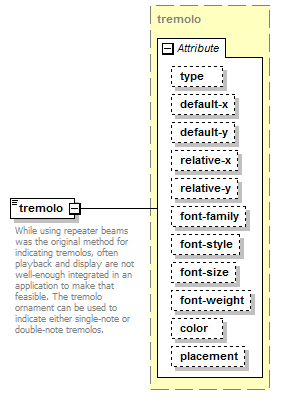tremolo
While using repeater beams was the original method for indicating tremolos, often playback and display are not well-enough integrated in an application to make that feasible. The tremolo ornament can be used to indicate either single-note or double-note tremolos. |
Element Information
Model

Attributes
| QName | Type | Fixed | Default | Use | Inheritable | Annotation |
|---|---|---|---|---|---|---|
| color | color | optional | ||||
| default-x | tenths | optional | ||||
| default-y | tenths | optional | ||||
| font-family | comma-separated-text | optional | ||||
| font-size | font-size | optional | ||||
| font-style | font-style | optional | ||||
| font-weight | font-weight | optional | ||||
| placement | above-below | optional | ||||
| relative-x | tenths | optional | ||||
| relative-y | tenths | optional | ||||
| type | start-stop-single | single | optional |
Source
<xs:element name="tremolo" type="tremolo"> <xs:annotation> <xs:documentation>While using repeater beams was the original method for indicating tremolos, often playback and display are not well-enough integrated in an application to make that feasible. The tremolo ornament can be used to indicate either single-note or double-note tremolos.</xs:documentation> </xs:annotation> </xs:element> |